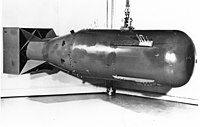
Photo from wikipedia
The burning and soot characteristics of RP-3 kerosene droplets under sub-atmospheric pressure were experimentally investigated in a pressure chamber. The droplet size during combustion was continuously recorded using a high-speed… Click to show full abstract
The burning and soot characteristics of RP-3 kerosene droplets under sub-atmospheric pressure were experimentally investigated in a pressure chamber. The droplet size during combustion was continuously recorded using a high-speed camera, and the burning rate based on the d2–law was determined. The flame temperature was calculated from ICCD camera spectral data using two-color pyrometry, and the carbon soot volume fraction was measured by the calibrated laser-induced incandescence (LII) technique. Soot particles were also sampled using a thermophoretic deposition probe and characterized using a transmission electron microscope (TEM) for particle size and morphology. The results showed that the droplet burning rate increased monotonically with increasing pressure under sub-atmospheric pressure, and the flame temperature slightly decreased with increasing pressure. Sub-atmospheric pressure environment significantly inhibits the formation of soot particle clusters during the ignition of droplets. The average soot volume fraction in the flame increases approximately with increasing pressure at 0.2–1.0 bar with a power of 2.044 ± 0.066. As the pressure decreases from 1.0 to 0.2 bar, the average soot volume fraction decreases significantly from 11.801 to 0.437 ppm. This is mainly due to the fact that the sub-atmospheric environment not only inhibits the collision growth of soot particles but also promotes the oxidation process of soot particles. The collected soot particles reveal a significant reduction in particle size under sub-atmospheric pressure with average primary soot particles of 48.23, 40.06, 27.096, and 18.718 nm at 1.0, 0.6, 0.4, and 0.3 bar pressures, respectively. The change in the number density of carbon soot particles is not significant, which reveals that the change in the diameter of soot particles under sub-atmospheric pressure plays a key role in the change in the volume fraction of soot.
Journal Title: ACS Omega
Year Published: 2023
Link to full text (if available)
Share on Social Media: Sign Up to like & get
recommendations!